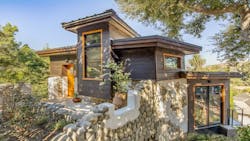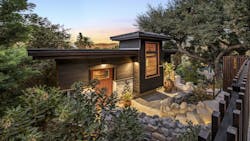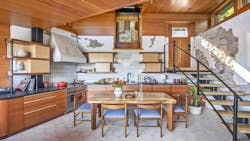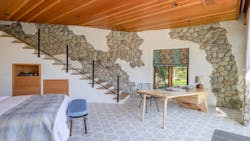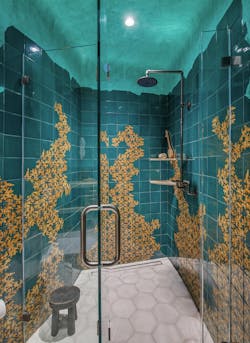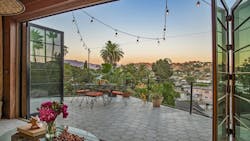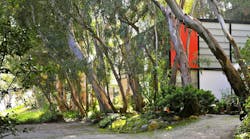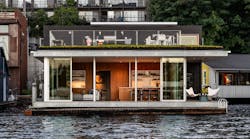Los Angeles ADU Marries Unique Renewable Materials With Contemporary Design Flair
An all-electric accessory dwelling unit (ADU) in Los Angeles’ Mt. Washington neighborhood provides its occupants with a modern living environment while staying true to its roots. Using natural materials from the area, the ADU blends in with the surrounding Craftsman-style homes while keeping the interiors uniquely its own.
Developed by Los Angeles-based design/build firm CarbonShack, the 800-square-foot ADU was constructed for Rachel Mayeri, a professor at Harvey Mudd College.
According to Stephen Pallrand, CarbonShack's founder, Mayeri reached out with the idea for the ADU to accompany her 2,200-square-foot Craftsman-style home. Because the lot was so large with an underused slope in the back, Mayeri sought to add another unit to the yard while maintaining the character of her existing 1927-era home.
“This was a perfect spot for an ADU because there’s a through street on the top of the lot,” Pallrand says. “The ADU can sit on the top of the lot, and [the occupant] can have their own access and not worry about issues around privacy or people walking through the backyard.”
Connecting to the Community’s Historic Roots
The finished product is an ADU that offers a fresh, modern take on the historic character of the home. From the outside, the ADU—aptly named Paraíso de Rocas Antiguas, which translates to Ancient Rock Paradise—takes on the appearance of a modest, single-level Craftsman home with wood panel siding.
Rocks from the nearby Arroyo Seco River can also be found at the entryway leading up to the home and on the exterior walls.
According to Pallrand, river rock is commonly used throughout the Mt. Washington neighborhood in landscaping, property walls, foundations, porches, and more, and was used as a design tool to further tie the ADU to its surroundings while creating a unique design narrative.
“A lot of interesting homes in the area were built using river rock. River rocks are one of the defining design features in the neighborhood,” Pallrand says. “So what we decided is, 'What if we had two river rock walls that looked as though they were ruins, or looked as though they predated the modern building that we've placed between those two walls?'”
Contemporary Interiors for Modern Living
While maintaining its historic presence on the outside, the home opens up into a spacious kitchen and living area. The home is contemporary in style with warm wooden elements throughout and occasional pieces of river rock peaking through, calling attention to the site’s long history.
“The ADU had to be fully contemporary in the way it operates," Pallrand says, "but it has to appear on the outside as though it fits into the historic fabric of the neighborhood.”
The ADU also takes advantage of the sloped ground, with a staircase leading down to a bedroom and bathroom. While the front of the ADU appears modest on the outside, the sloped ground allows it to open up to a view of the surrounding Mt. Washington neighborhood. At the same time, the property is designed for privacy, with stacked-stone terraces of fruit trees and native plants providing a barrier between the ADU and the main house.
Furnishings That Inspire Health and Wellness
The home’s furnishings—also by CarbonShack—are crafted with the natural world in mind. The eco-friendly materials used throughout the ADU aim to reduce negative impacts on the environment, and the design puts nature at the forefront.
The interior millwork and furniture are created from salvaged urban trees, such as the California sycamore or the Samuel ash.
Fabrics and drapery feature custom hemp textiles adorned with patterns inspired by kelp and plant cell structures, and the bathroom features hand-painted coral-pattern tile produced locally.
Additionally, the ADU features PaperStone countertops, a surface material made from 100% recycled paper.
Reducing Its Impact on the Natural World
In addition to its custom sustainable furnishings, the home reduces its environmental impact in a number of other ways. The all-electric ADU optimizes energy through the use of solar panels, LED lighting, and heat pumps.
These measures ensure energy independence and a faster return on solar investment. The ADU looks out over a drought-tolerant native garden featuring edible plants. Water efficiency is also enhanced with drip irrigation, rain sensors, and graywater systems that naturally direct runoff into the landscape.
The ADU is also situated under a century-old live oak tree, which helps to reduce heat gain and provide cooling shade. Tall doors and clerestory windows furtherhelp to flood the home with natural light and provide ventilation.
As Pallrand explains, CarbonShack’s focus on better health and wellness for the occupant of the ADU helped to maintain energy independence and minimize damage to the environment. “We’re taking advantage of nature, and we’re bringing nature into the home," he says. "But we’re also reducing our impact on nature.”
Project Credits:
Design-Build: CarbonShack
Countertops: PaperStone
Read more: Case Studies | 1919 Craftsman Renovation | Design Details
About the Author
Catherine Sweeney
Catherine Sweeney is the associate editor for Pro Builder and Custom Builder, where she creates both digital and print content, including Pro Builder’s daily e-newsletter and various news stories for both brands. Before joining Endeavor, she began her career in local journalism, later pivoting to the commercial real estate industry where she worked for several years as a reporter and editor.
